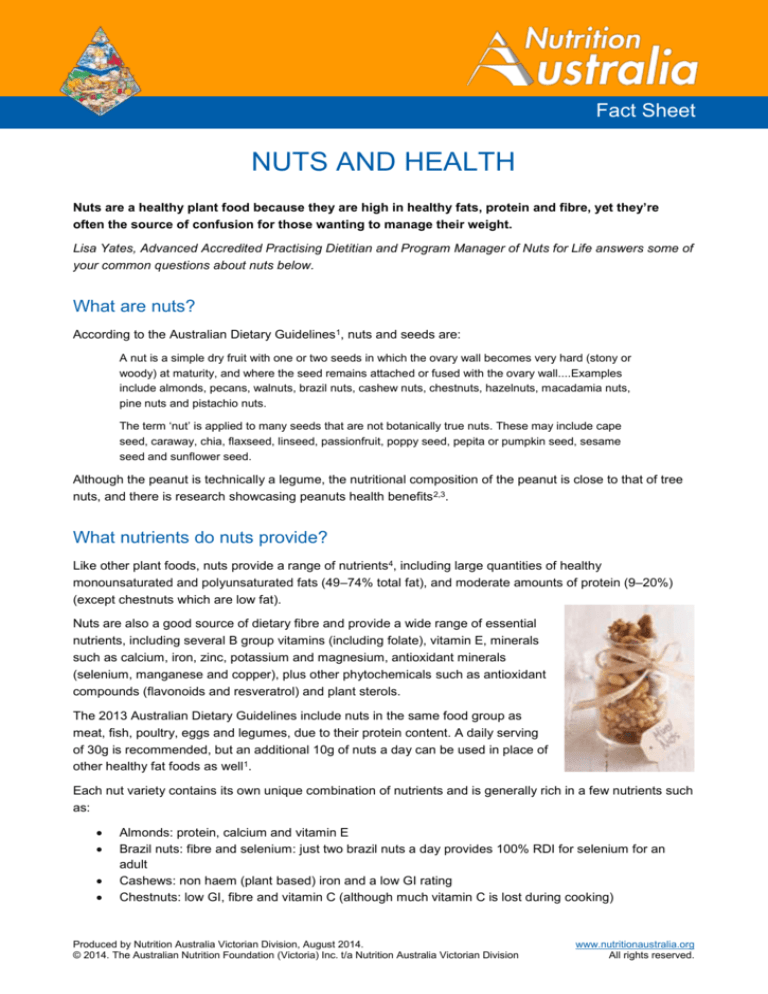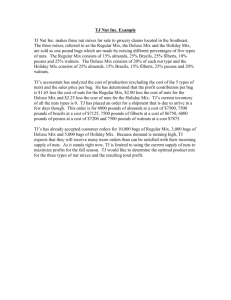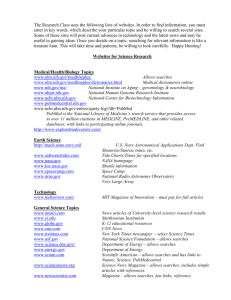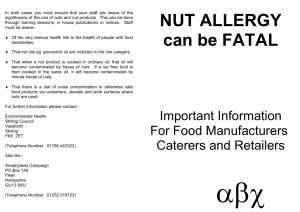
Fact Sheet
NUTS AND HEALTH
Nuts are a healthy plant food because they are high in healthy fats, protein and fibre, yet they’re
often the source of confusion for those wanting to manage their weight.
Lisa Yates, Advanced Accredited Practising Dietitian and Program Manager of Nuts for Life answers some of
your common questions about nuts below.
What are nuts?
According to the Australian Dietary Guidelines1, nuts and seeds are:
A nut is a simple dry fruit with one or two seeds in which the ovary wall becomes very hard (stony or
woody) at maturity, and where the seed remains attached or fused with the ovary wall....Examples
include almonds, pecans, walnuts, brazil nuts, cashew nuts, chestnuts, hazelnuts, macadamia nuts,
pine nuts and pistachio nuts.
The term ‘nut’ is applied to many seeds that are not botanically true nuts. These may include cape
seed, caraway, chia, flaxseed, linseed, passionfruit, poppy seed, pepita or pumpkin seed, sesame
seed and sunflower seed.
Although the peanut is technically a legume, the nutritional composition of the peanut is close to that of tree
nuts, and there is research showcasing peanuts health benefits 2,3.
What nutrients do nuts provide?
Like other plant foods, nuts provide a range of nutrients4, including large quantities of healthy
monounsaturated and polyunsaturated fats (49–74% total fat), and moderate amounts of protein (9–20%)
(except chestnuts which are low fat).
Nuts are also a good source of dietary fibre and provide a wide range of essential
nutrients, including several B group vitamins (including folate), vitamin E, minerals
such as calcium, iron, zinc, potassium and magnesium, antioxidant minerals
(selenium, manganese and copper), plus other phytochemicals such as antioxidant
compounds (flavonoids and resveratrol) and plant sterols.
The 2013 Australian Dietary Guidelines include nuts in the same food group as
meat, fish, poultry, eggs and legumes, due to their protein content. A daily serving
of 30g is recommended, but an additional 10g of nuts a day can be used in place of
other healthy fat foods as well1.
Each nut variety contains its own unique combination of nutrients and is generally rich in a few nutrients such
as:
Almonds: protein, calcium and vitamin E
Brazil nuts: fibre and selenium: just two brazil nuts a day provides 100% RDI for selenium for an
adult
Cashews: non haem (plant based) iron and a low GI rating
Chestnuts: low GI, fibre and vitamin C (although much vitamin C is lost during cooking)
Produced by Nutrition Australia Victorian Division, August 2014.
© 2014. The Australian Nutrition Foundation (Victoria) Inc. t/a Nutrition Australia Victorian Division
www.nutritionaustralia.org
All rights reserved.
Hazelnuts: fibre, potassium, folate, vitamin E
Macadamias: highest in monounsaturated fats, thiamin and manganese
Pecans: fibre and antioxidants
Pine nuts: vitamin E and the arginine amino acid
Pistachios: protein, potassium, plant sterols and the antioxidant resveratrol
Walnuts: alpha linoleic acid: plant omega 3 and antioxidants
Nuts are naturally low in sodium, contain potassium and most contain some carbohydrate in the form of
natural sugars. Chestnuts are different they are rich in low glycemic index carbohydrates and low in fat
making them more like a grain than a tree nut.
Is there a nutritional difference between raw and roasted nuts?
There are little differences in the nutrient content of raw and roasted nuts. Nuts can be oil or dry roasted, but
nuts are so dense they are unable to absorb much oil (approximately 2-5% of the oil they are cooked in)5.
Roasting does reduce the water content of nuts, concentrating the nutrients, but also reduces the
concentration of several B group vitamins as they are not heat stable.
While it is possible to buy unsalted, dry roasted nuts. Many oil roasted nut varieties are salted and therefore
have a higher sodium content than raw nuts. If you like the taste of roasted nuts, but want to reduce your salt
intake, choose unsalted roasted nuts and leave the salted ones for special occasions only.
Roasting does bring out the flavours of nuts making them taste....well nuttier6,7.
Are nuts good for heart health?
Studies suggest that consuming about 30g (a handful) of nuts per day may reduce the risk of developing
heart disease by 30-50%8-14 and reduce the risk of death from heart disease by around 20%15.
This is based on the high proportion of healthy monounsaturated and polyunsaturated fats in nuts, and the
low proportion of saturated fats, and the results of studies comparing heart disease rates among people who
eat nuts with those who do not.
It seems a number of heart-healthy nutrients in nuts work together to achieve this heart protective effect.
These include:
Health-promoting monounsaturated and polyunsaturated fats that help regulate blood cholesterol
Fibre and plant sterols that help reduce cholesterol re-absorption from the gut
Arginine (an amino acid which is converted to nitric oxide in the body) which helps keep blood
vessels elastic, thereby reducing the risk of atherosclerosis (hardening of the arteries)
Antioxidant vitamins and minerals, e.g. vitamin E, copper, manganese, selenium and zinc, and other
antioxidant compounds such as flavonoids and resveratrol that reduce oxidation and inflammation
Naturally low sodium and high potassium levels which assist in maintaining healthy blood pressure.
Eating an average of 67g of nuts a day can also help improve your cholesterol16.
Nuts and health
www.nutritionaustralia.org
2
Do nuts affect my risk of developing type 2 diabetes?
Nuts may also help prevent developing type 2 diabetes, although more research is
needed.
A large study found that women who ate about 30g of nuts per day on five or more days
of the week had approximately 30% less risk of developing type 2 diabetes compared
with those who ate few or no nuts17. This effect was attributed at least partly to the high
levels of monounsaturated and polyunsaturated fats found in nuts, which (in addition to
their positive effects on blood cholesterol) are believed to enhance insulin sensitivity. A
Harvard meta analysis, which groups together many studies, found a 13% reduced risk of
type 2 diabetes when four 30g (approx) serves of nuts are eaten each week18.
Nuts can benefit people with type 2 diabetes, as they help reduce the overall glycemic index of the diet.
When added to meals rich in carbohydrate, nuts slow the passage of the meal through the gut and reduce
blood glucose levels following the meal19-22 and the phytochemicals found in nut skins may slow
carbohydrate digestion23.
Nuts can also help reduce the risk of developing Metabolic Syndrome – a cluster of metabolic measures that
if left untreated can lead to type 2 diabetes, heart disease and hypertension (high blood pressure) 24,25.
Should I avoid nuts if I don’t want to gain weight?
A small handful of nuts (30–50g) each day is not associated with a weight gain, and may also help reduce
the risk of obesity10-13, 26-28. The healthy fats in nuts can help you feel fuller, which helps to control
appetite29,30.
And since some fat is trapped in the fibrous structure of the nut, it passes through the body rather than being
digested30-33.
Nuts can be part of a healthy diet to maintain or even lose weight, as long as your overall kilojoule intake
does not increase. Eating a handful of nuts as a substitute for less healthy foods such as muffins, biscuits,
cakes, chips, chocolate and so on.
Can I eat nuts in a Mediterranean diet?
Including a handful of nuts (30g) every day in a Mediterranean diet or using extra virgin olive oil has more
health benefits than a reduced fat diet. One study found the following:
Reduced cardiovascular events (such as myocardial infarction, stroke, and death from
cardiovascular causes).
A lifetime habit of eating a handful of nuts (30g) more than three times a week resulted in a 39%
reduction in total mortality in an older Mediterranean population at high risk of cardiovascular
disease.
BMI and waist circumference decreased by 0.78kg/m2 and 2.1cm respectively, for each additional
serving of nuts eaten.
50% reduction in diabetes incidence, compared to following the low-fat diet over four years.
26% reduction in metabolic syndrome comparing those eating three or more serves of nuts per week
with one or fewer serves per week.
For more information, download the PREDIMED summary paper at www.nutsforlife.com.au/resources/literature-reviews-summaries/
Nuts and health
www.nutritionaustralia.org
3
What about nut allergies?
Nut allergies are a major concern for a small proportion of the population. People can be allergic to:
one or more of the tree nuts (almonds, Brazil nuts, cashews, chestnuts, hazelnuts, macadamias,
pecans, pine nuts, pistachios and walnuts)
peanuts only
both tree nuts and peanuts.
For more information on managing tree nut allergy, download this Allergy and Anaphylaxis Australia reviewed fact sheet
http://www.nutsforlife.com.au/wp-content/uploads/pdf/health-fact-sheets/Nuts-and-allegy-factsheet-2012.pdf
Other health benefits of nuts?
Although more research is required, preliminary studies have indicated that nuts may play a role in:
Reducing the risk of gall stones34-35
Reducing age-related macular degeneration (which can lead to blindness) 36
Maintaining bone health37
Slowing brain aging38
Reducing cancer risk15.
How much nuts should I have?
A healthy daily intake of nuts is 30g (a small handful) or approximately:
20 almonds
15 cashews
20 hazelnuts
15 macadamias
15 pecans
2 tablespoons of pine nuts
30 pistachio kernels
9 walnut kernels
a small handful of mixed nuts or about
two of each of the ten nut varieties
(except chestnut which isn’t eaten
raw)
Acknowledgements
Lisa Yates is an Advanced Accredited Practising Dietitian and Program Manager of
Nuts for Life, a health education initiative of the Australia Tree Nut Industry and
Horticulture Australia.
For more information on including nuts to your diet, visit http://www.nutsforlife.com.au/
or follow @nutsforlife on twitter, www.facebook.com/nuts4life and pin at
www.pinterest.com/nutsforlife
Nuts and health
www.nutritionaustralia.org
4
References
1.
2.
3.
4.
5.
6.
7.
8.
9.
10.
11.
12.
13.
14.
15.
16.
17.
18.
19.
20.
21.
22.
23.
24.
25.
26.
27.
28.
29.
30.
31.
32.
33.
34.
35.
36.
37.
38.
National Health and Medical Research Council (2013) Australian Dietary Guidelines. Canberra: National Health and Medical Research Council.
www.eatforhealth.gov.au
Kris-Etherton PM, Hu FB, Ros E, Sabaté J. The role of tree nuts and peanuts in the prevention of coronary heart disease: multiple potential
mechanisms. J Nutr. 2008 Sep;138(9):1746S-1751S. http://www.ncbi.nlm.nih.gov/pubmed/18716180
Francisco ML, Resurreccion AV. Functional components in peanuts. Crit Rev Food Sci Nutr. 2008 Sep;48(8):715-46. doi:
10.1080/10408390701640718. http://www.ncbi.nlm.nih.gov/pubmed/18756396
Nuts for Life. Nuts for Life Nutrient Composition of Tree Nuts 2014. http://www.nutsforlife.com.au/resources/nutrient-composition
Personal communication to the author from members of the Australian Tree Nut Industry.
Burdack-Freitag A, Schieberle P. Changes in the key odorants of Italian Hazelnuts ( Coryllus avellana L. Var. Tonda Romana) induced by roasting. J
Agric Food Chem. 2010 May 26;58(10):6351-9. doi: 10.1021/jf100692k. http://www.ncbi.nlm.nih.gov/pubmed/20426421
Agila A, Barringer S Effect of roasting conditions on color and volatile profile including HMF level in sweet almonds (Prunus dulcis). J Food Sci. 2012
Apr;77(4):C461-8. doi: 10.1111/j.1750-3841.2012.02629.x. http://www.ncbi.nlm.nih.gov/pubmed/22429278
Li TY, Brennan AM, Wedick NM, Mantzoros C, Rifai N, Hu FB. Regular consumption of nuts is associated with a lower risk of cardiovascular disease
in women with type 2 diabetes. J Nutr. 2009 Jul;139(7):1333-8. http://www.ncbi.nlm.nih.gov/pubmed/19420347
Blomhoff R. et al. Health benefits of nuts: potential role of antioxidants. Brit J Nutr 2007;96(SupplS2):S52-S60.
http://www.ncbi.nlm.nih.gov/pubmed/17125534
Albert C.M. et al. Nut consumption and decreased risk of sudden cardiac death in the Physicians Health Study. Arch Intern Med 2002;162(12):1382-7.
http://www.ncbi.nlm.nih.gov/pubmed/12076237
Ellsworth JL, Kushi LH, Folsom AR. Frequent nut intake and risk of death from coronary heart disease and all causes in postmenopausal women: the
Iowa Women's Health Study. Nutrition Metabolism and Cardiovascular Disease 2001;11(6):372-7. http://www.ncbi.nlm.nih.gov/pubmed/12055701
Hu FB, Stampfer MJ, Manson JE, Rimm EB, Colditz GA, Rosner BA, et al. Frequent nut consumption and risk of coronary heart disease in women:
prospective cohort study. British Medical Journal 1998;317(7169):1341-5. http://www.ncbi.nlm.nih.gov/pubmed/9812929
Fraser, G.E., et al. A possible protective effect of nut consumption on risk of coronary heart disease. Arch Intern Med 1991; 152: 1416-24.
http://www.ncbi.nlm.nih.gov/pubmed/1627021
Ghadimi Nouran M, Kimiagar M, Abadi A, Mirzazadeh M, Harrison G. Peanut consumption and cardiovascular risk. Public Health Nutr. 2010
Oct;13(10):1581-6. http://www.ncbi.nlm.nih.gov/pubmed/20025830
Bao Y, Han J, Hu FB, Giovannucci EL, Stampfer MJ, Willett WC, Fuchs CS. Association of nut consumption with total and cause-specific mortality. N
Engl J Med. 2013 Nov 21;369(21):2001-11. http://www.ncbi.nlm.nih.gov/pubmed/24256379
Sabaté J, Oda K, Ros E. Nut consumption and blood lipid levels: a pooled analysis of 25 intervention trials. Arch Intern Med. 2010 May
10;170(9):821-7. http://www.ncbi.nlm.nih.gov/pubmed/20458092
Jiang R, Manson JE, Stampfer MJ, Liu S, Willett WC, Hu FB. Nut and peanut butter consumption and risk of type 2 diabetes in women. Journal of the
American Medical Association 2002;288(20):2554-60. http://www.ncbi.nlm.nih.gov/pubmed/12444862
Afshin A, Micha R, Khatibzadeh S, Mozaffarian D. Consumption of nuts and legumes and risk of incident ischemic heart disease, stroke, and
diabetes: a systematic review and meta-analysis. Am J Clin Nutr. 2014 Jun 4. pii: ajcn.076901. [Epub ahead of print]
http://www.ncbi.nlm.nih.gov/pubmed/24898241
Kendall CW, Esfahani A, Josse AR, Augustin LS, Vidgen E, Jenkins DJ. The glycemic effect of nut-enriched meals in healthy and diabetic subjects.
Nutr Metab Cardiovasc Dis. 2011 Jun;21 Suppl 1:S34-9. http://www.ncbi.nlm.nih.gov/pubmed/21561748
Reis CE, Bordalo LA, Rocha AL, Freitas DM, da Silva MV, de Faria VC, Martino HS, Costa NM, Alfenas RC. Ground roasted peanuts leads to a lower
post-prandial glycemic response than raw peanuts. Nutr Hosp. 2011 Jul-Aug;26(4):745-51. http://www.ncbi.nlm.nih.gov/pubmed/22470019
Jenkins DJ, Kendall CW, Banach MS et al. Nuts as a replacement for carbohydrates in the diabetic diet. Diabetes Care. 2011 Aug;34(8):1706-11.
http://www.ncbi.nlm.nih.gov/pubmed/21715526
Kendall CW, Josse AR, Esfahani A, Jenkins DJ. The impact of pistachio intake alone or in combination with high-carbohydrate foods on post-prandial
glycemia. Eur J Clin Nutr. 2011 Jun;65(6):696-702. http://www.ncbi.nlm.nih.gov/pubmed/21364607
Tsujita T, Shintani T, Sato H. α-Amylase inhibitory activity from nut seed skin polyphenols. 1. Purification and characterization of almond seed skin
polyphenols. J Agric Food Chem. 2013 May 15;61(19):4570-6. http://www.ncbi.nlm.nih.gov/pubmed/23614772
Salas-Salvadó J, Guasch-Ferré M, Bulló M, Sabaté J. Nuts in the prevention and treatment of metabolic syndrome. Am J Clin Nutr. 2014 Jun 4. pii:
ajcn.071530. [Epub ahead of print] http://www.ncbi.nlm.nih.gov/pubmed/24898227
Jaceldo-Siegl K, Haddad E, Oda K, Fraser GE, Sabaté J Tree nuts are inversely associated with metabolic syndrome and obesity: the Adventist
health study-2. PLoS One. 2014 Jan 8;9(1):e85133. http://www.ncbi.nlm.nih.gov/pubmed/24416351
Jackson CL, Hu FB. Long-term associations of nut consumption with body weight and obesity. Am J Clin Nutr. 2014 Jun 4. pii: ajcn.071332. [Epub
ahead of print] http://www.ncbi.nlm.nih.gov/pubmed/24898229
Flores-Mateo G, Rojas-Rueda D, Basora J, Ros E, Salas-Salvadó J. Nut intake and adiposity: meta-analysis of clinical trials. Am J Clin Nutr. 2013
Jun;97(6):1346-55. http://www.ncbi.nlm.nih.gov/pubmed/23595878
Martínez-González MA, Bes-Rastrollo M. Nut consumption, weight gain and obesity: Epidemiological evidence. Nutr Metab Cardiovasc Dis. 2011
Jun;21 Suppl 1:S40-5. http://www.ncbi.nlm.nih.gov/pubmed/21216574
Pasman WJ, Heimerikx J, Rubingh CM et al The effect of Korean pine nut oil on in vitro CCK release, on appetite sensations and on gut hormones in
post-menopausal overweight women. Lipids Health Dis.2008 Mar 20;7:10. http://www.ncbi.nlm.nih.gov/pubmed/18355411
Cassady BA, Hollis JH, Fulford AD, Considine RV, Mattes RD. Mastication of almonds: effects of lipid bioaccessibility, appetite, and hormone
response. Am J Clin Nutr. 2009 Mar;89(3):794-800. http://www.ncbi.nlm.nih.gov/pubmed/19144727
Baer DJ, Gebauer SK, Novotny JA Measured energy value of pistachios in the human diet. Br J Nutr. 2012 Jan;107(1):120-5.
http://www.ncbi.nlm.nih.gov/pubmed/21733319
Mattes RD. The energetics of nut consumption. Asia Pac J Clin Nutr. 2008;17 Suppl 1:337-9. http://www.ncbi.nlm.nih.gov/pubmed/18296372
Novotny JA, Gebauer SK, Baer DJ. Discrepancy between the Atwater factor predicted and empirically measured energy values of almonds in human
diets. Am J Clin Nutr. 2012 Aug;96(2):296-301. http://www.ncbi.nlm.nih.gov/pubmed/22760558
Tsai CJ, Leitzmann MF, Hu FB, Willett WC, Giovannucci EL. A prospective cohort study of nut consumption and the risk of gallstone disease in men.
Am J Epidemiol. 2004 Nov 15;160(10):961-8. http://www.ncbi.nlm.nih.gov/pubmed/15522852
Tsai CJ, Leitzmann MF, Hu FB, Willett WC, Giovannucci EL. Frequent nut consumption and decreased risk of cholecystectomy in women. Am J Clin
Nutr. 2004 Jul;80(1):76-81. http://www.ncbi.nlm.nih.gov/pubmed/15213031
Tan JS, Wang JJ, Flood V, Mitchell P. Dietary fatty acids and the 10-year incidence of age-related macular degeneration: the Blue Mountains Eye
Study. Arch Ophthalmol. 2009 May;127(5):656-65. http://www.ncbi.nlm.nih.gov/pubmed/19433717
Platt ID, Josse AR, Kendall CW, Jenkins DJ, El-Sohemy A. Postprandial effects of almond consumption on human osteoclast precursors-an ex vivo
study. Metabolism. 2011 Jul;60(7):923-9. http://www.ncbi.nlm.nih.gov/pubmed/20947104
O'Brien J, Okereke O, Devore E, Rosner B, Breteler M, Grodstein F. Long-term intake of nuts in relation to cognitive function in older women. J Nutr
Health Aging. 2014;18(5):496-502. http://www.ncbi.nlm.nih.gov/pubmed/24886736
Nuts and health
www.nutritionaustralia.org
5







